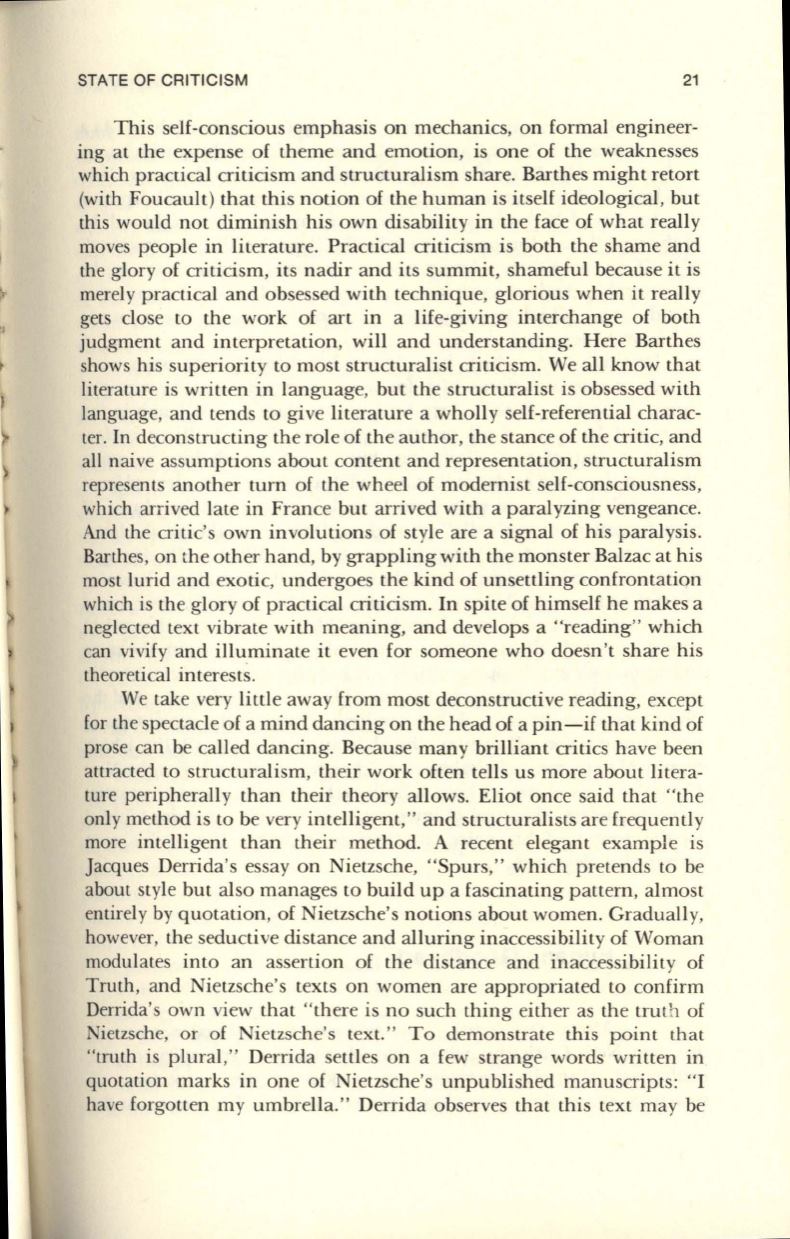
STATE OF CRITICISM
21
This self-conscious emphasis on mechanics, on formal engineer–
ing at the expense of theme and emotion, is one of the weaknesses
which practical criticism and structuralism share. Barthes might retort
(with Foucault) that this notion of the human is itself ideological , but
this would not diminish his own disability in the face of what really
moves people in literature. Practical criticism is both the shame and
the glory of criticism, its nadir and its summit, shameful because it is
merely practical and obsessed with technique, glorious when it really
gets close to the work of art in a life-giving interchange of both
judgment and interpretation, will and understanding. Here Barthes
shows his superiority to most structuralist criticism. We all know that
literature is written in language, but the structuralist is obsessed with
language, and tends to give literature a wholly self-referential charac–
ter. In deconstructing the role of the author, the stance of the critic, and
all naive assumptions about content and representation, structuralism
represents another turn of the wheel of modernist self-consciousness,
which arrived late in France but arrived with a paralyzing vengeance.
And the critic's own involutions of style are a signal of his paralysis.
Barthes, on the other hand, by grappling with the monster Balzac at his
most lurid and exotic, undergoes the kind of unsettling confrontation
which is the glory of practical criticism.
In
spite of himself he makes a
neglected text vibrate with meaning, and develops a "reading" which
can vivify and illuminate it even for someone who doesn't share his
theoretical interests.
We take very little away from most deconstructive reading, except
[or the spectacle of a mind dancing on the head of a pin-if that kind of
prose can be called dancing. Because many brilliant critics have been
attracted to structuralism, their work often tells us more about litera–
ture peripherally than their theory allows. Eliot once said that "the
only method is to be very intelligent," and structuralists are frequently
more intelligent than their method. A recent elegant exampl e is
Jacques Derrida's essay on Nietzsche, "Spurs," which pretends to be
about style but also manages to build up a fascinating pattern, almost
entirely by quotation, of Nietzsche's notions about women. Gradually,
however, the seductive distance and alluring inaccessibility of Woman
modulates into an assertion of the distance and inaccessibility of
Truth, and Nietzsche's texts on women are appropriated to confirm
Derrida's own view that " there is no such thing either as the truth of
Nietzsche, or of Nietzsche's text." To demonstrate this point that
"truth is plural," Derrida settles on a few strange words written in
quotation marks in one of Nietzsche's unpublished manuscripts: "I
have forgotten my umbrella." Derrida observes that this text may be


